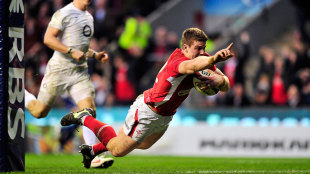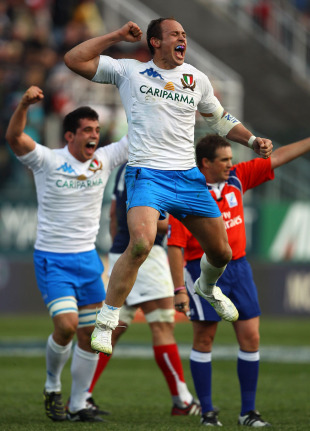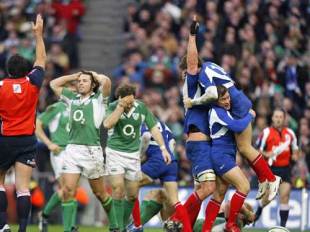|
Numbers Game
Comeback kings
Huw Richards
January 15, 2013

Scott Williams caps Wales' comeback versus England in 2012. The Welsh have the best record of coming back from half-time deficits
© PA Photos
Enlarge
"The emotional Welsh nature responds very readily to early success, but is just as easily depressed when its opponent gets out and up early". So opined the Sportsman's rugby reporter in 1910, inspired by England's victory - launched by a first-minute try - in the first international match at Twickenham. Sharp analysis or blind prejudice? One test of how well a team responds to adversity is whether it can come from behind to to win. And how often this happens is a question raised by Trevor Ruane from Ireland, to whom thanks. The answer is necessarily a qualified one. To respond fully, we would need to know the scoring sequence of every match, a level of detail beyond even the considerable resources of Statsguru. But it does give us half-time scores and a means of comparing them with final outcomes. The answer, taken across Home/Five/Six Nations championship history since 1890 (the first year in which matches were decided on points scored), is that just under one in six of winning teams - 165 out of 1025 - were behind at half-time, while a further 84 were drawing at the interval. More than three-quarters of winning teams - 776 of them - were already ahead at half-time. It is when we break these figures down by team that they become particularly intriguing. Wales account for by far the largest share of victories from behind, with 49. Scotland are next on 33, followed by France (29), Ireland (28), England (24) and Italy (2). If we compare this to total victories, we see that more than one in five of Wales's championship wins (49 out of 231) have come after trailing at the break compared to just over one in ten (24 out of 235) of England's. Ireland have been on the receiving end most often, losing 47 matches they were winning at the break. After them come England (35), Scotland (28), Wales (26), France (23) and Italy (6).

Italy's best ever result came after they cameback to defeat France in 2011
© Getty Images
Enlarge
It is therefore no great surprise that the fixture likeliest to see the lead changing hands after half-time is Wales v Ireland. Wales have trailed Ireland at the break on 18 occasions before winning - most recently last year and most persistently in the 1980s and 1990s when they performed this party trick four times on five visits to Lansdowne Road between 1986 and 1994. Ireland have turned Wales over seven times. Had every Wales v Ireland championship match finished as it stood at half-time, Ireland would enjoy a 56-51 all-time lead. Instead Wales have 62 wins to Ireland's 45. But the fixture with the greatest imbalance is Wales v England. It saw the first victory by a team trailing at the break, Wales's 12-11 win on a Cardiff icefield in 1893, clinched by the first international penalty-goal, drop-kicked by Wales's Billy Bancroft. Wales have had the edge in comebacks ever since, 13 times overcoming an interval deficit to win, while England have managed it only twice - and never in Wales. England's two victories from behind were at Twickenham in 1974 and 1980. By contrast eight of Wales's 13 wins at Twickenham have been from behind at the break. Five of them - 1950,1952,1978,2008 and 2012 - were in Welsh Grand Slam Years. Another, in 1970, saw the first time a championship team had overturned a double-figure interval deficit. Wales, inspired by replacement scrum-half Chico Hopkins, scored 14 points unanswered after trailing 13-3 at the break. The 2008 Grand Slammers emulated that feat, and these two Welsh victories are among only four occasions on which a double-figure deficit has been overturned. The other two saw France coming back from 11 points behind at Lansdowne Road in 1989, with Patrick Lagisquet scoring two of their four tries, and at Twickenham in 2005, where Dimitri Yachvili kicked all of their points with six penalties. That Twickenham record underlines two other Welsh distinctions. They have a huge lead in away wins from behind, with 28 to 16 by France, followed by Ireland (13), England (9) and Scotland, who have come from behind 26 times at home but only seven times on the road. Revivals have made a huge contribution to Wales's 11 Grand Slams. Only two, those of 1908 and 1976, were accomplished without at least one win from behind. The teams of 1952, 2008 and 2012 trailed in two of their matches at the break. England, by contrast, would have lost only three of their 12 Grand Slams - those of 1914, 1928 and 1980 - had half-time scores carried through to the end. Five of France's nine Grand Slams (though none of the three they have won this century) included a recovery, all three of Scotland's and Ireland's second in 2009, although not the first 61 years earlier. Two victories from behind remains the record for a single season. Having five matches rather than four should make this record vulnerable, but victories from behind have become rarer in the Six Nations era with only 27 in 195 matches (Wales 9, France 5, England and Ireland 4, Scotland 3, Italy 2) since 2000. This compares to the 27 wins from behind in 100 matches during the 1980s, comfortably the most fertile decade for comebacks. Modern players do, however, lead the all-time standings for involvement in comebacks. Ryan Jones's presence at Twickenham last season was the 8th time he had played in a team that won after trailing at the break, drawing him level with Fabien Pelous (who has also captained most comeback teams, with four). Neil Jenkins and David Young, with seven wins, were the previous record holders while the first to six was the durable Scotsman (and later Liberal Peer) John Bannerman in 1929, followed by a clutch of Irishmen - Jammie Clinch, Mark Sugden and George Stephenson - in the early 1930s.

Ireland have been on the end of the most comebacks
© Getty Images
Enlarge
They remain their national record holders, while the English comeback record is shared by two men with north-eastern roots and four wins, wing Rory Underwood and 1960s midfield back Mike Weston. Fourteen of the 25 players with six comeback wins or more are Welsh. Those most on the receiving end are overwhelmingly Irish. They lost after a half-time lead 11 times in 28 matches between 1986 and 1992, including a single-season record of three in 1986. Little wonder that three stalwarts of that era, Michael Kiernan, Donal Lenihan and Brendan Mullin, hold the record for this particular form of rugby mortification, with 11 defeats. It is a long way down the list to the first non-Irishman, that fine English hooker Peter Wheeler (7). If Wales are the team to be beware when leading at half-time, it is generally unprofitable to be drawing with France, who have won 29 times out of 35 from an interval deadlock. This includes all 12 times against Scotland (whose overall record is a grim 9 wins and 26 defeats and also includes 9 defeats from 11 half-time draws against England) and eight times out of nine against Wales, the single exception the Stade Colombes loss to a Rees Stephens-inspired team which deprived France of its first championship and Grand Slam in 1954. Wales have the edge in head to heads with other opponents, while the exception to Scotland's second-half misery is a record of three wins to nil from half-time stalemates against Ireland. (This analysis excludes matches which have been draws at both half-time and full-time). If we extend the winning-from-behind category to all international matches, Wales still lead, with 64 comeback victories to 56 for France and 50 for New Zealand. To finish where we started, with The Sportsman's ethnic theorist of 1910, it would seem that he was about as accurate as most sports analysts drawing on such stereotypes, particularly those casting a none-too-perceptive eye on smaller neighbours. © ESPN Sports Media Ltd.
|
Live Sports
Communication error please reload the page.
-
Football
-
Cricket
-
Rugby
-
- Days
- Hrs
- Mins
- Secs
F1 - Abu Dhabi GP
Abu Dhabi Grand Prix December 11-131. Max Verstappen ()
2. Valtteri Bottas (Mercedes)
3. Lewis Hamilton (Mercedes)
4. Alexander Albon ()
5. Lando Norris ()
6. Carlos Sainz Jr ()
-
ESPNOtherLive >>
Snooker - China Open
Tennis - Miami Open

